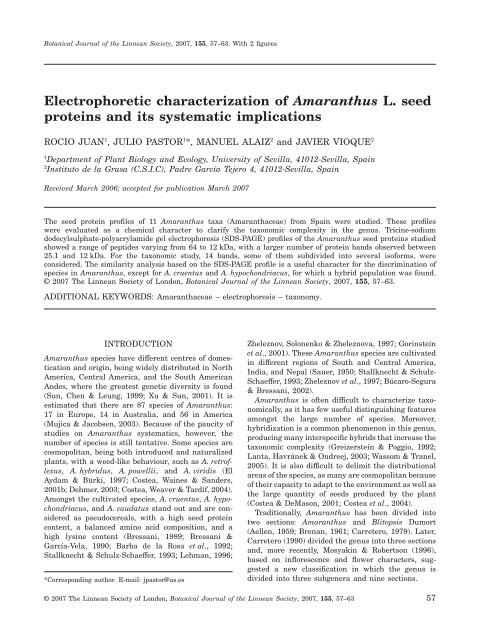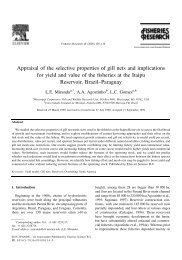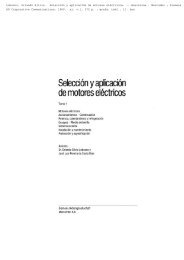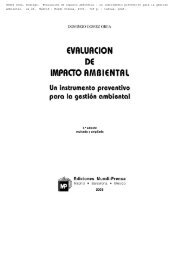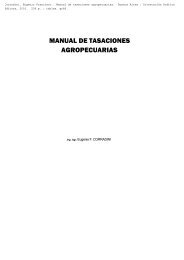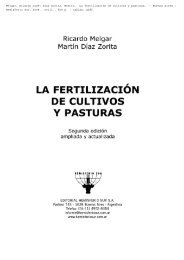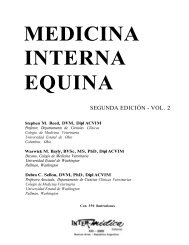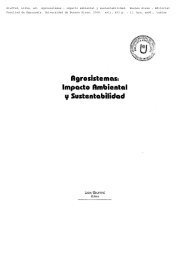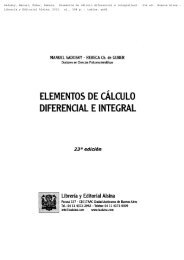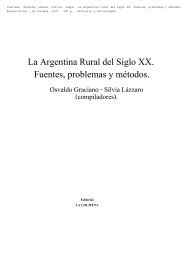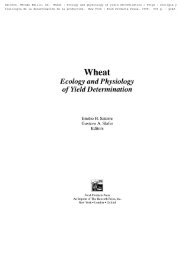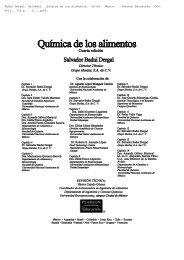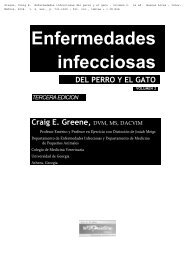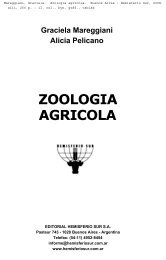Electrophoretic characterization of Amaranthus L. seed proteins and ...
Electrophoretic characterization of Amaranthus L. seed proteins and ...
Electrophoretic characterization of Amaranthus L. seed proteins and ...
You also want an ePaper? Increase the reach of your titles
YUMPU automatically turns print PDFs into web optimized ePapers that Google loves.
Botanical Journal <strong>of</strong> the Linnean Society, 2007, 155, 57–63. With 2 figures<strong>Electrophoretic</strong> <strong>characterization</strong> <strong>of</strong> <strong>Amaranthus</strong> L. <strong>seed</strong><strong>proteins</strong> <strong>and</strong> its systematic implicationsROCIO JUAN 1 , JULIO PASTOR 1 *, MANUEL ALAIZ 2 <strong>and</strong> JAVIER VIOQUE 21Department <strong>of</strong> Plant Biology <strong>and</strong> Ecology, University <strong>of</strong> Sevilla, 41012-Sevilla, Spain2Instituto de la Grasa (C.S.I.C), Padre García Tejero 4, 41012-Sevilla, SpainReceived March 2006; accepted for publication March 2007The <strong>seed</strong> protein pr<strong>of</strong>iles <strong>of</strong> 11 <strong>Amaranthus</strong> taxa (Amaranthaceae) from Spain were studied. These pr<strong>of</strong>ileswere evaluated as a chemical character to clarify the taxonomic complexity in the genus. Tricine-sodiumdodecylsulphate-polyacrylamide gel electrophoresis (SDS-PAGE) pr<strong>of</strong>iles <strong>of</strong> the <strong>Amaranthus</strong> <strong>seed</strong> <strong>proteins</strong> studiedshowed a range <strong>of</strong> peptides varying from 64 to 12 kDa, with a larger number <strong>of</strong> protein b<strong>and</strong>s observed between25.1 <strong>and</strong> 12 kDa. For the taxonomic study, 14 b<strong>and</strong>s, some <strong>of</strong> them subdivided into several is<strong>of</strong>orms, wereconsidered. The similarity analysis based on the SDS-PAGE pr<strong>of</strong>ile is a useful character for the discrimination <strong>of</strong>species in <strong>Amaranthus</strong>, except for A. cruentus <strong>and</strong> A. hypochondriacus, for which a hybrid population was found.© 2007 The Linnean Society <strong>of</strong> London, Botanical Journal <strong>of</strong> the Linnean Society, 2007, 155, 57–63.ADDITIONAL KEYWORDS: Amaranthaceae – electrophoresis – taxonomy.INTRODUCTION<strong>Amaranthus</strong> species have different centres <strong>of</strong> domestication<strong>and</strong> origin, being widely distributed in NorthAmerica, Central America, <strong>and</strong> the South AmericanAndes, where the greatest genetic diversity is found(Sun, Chen & Leung, 1999; Xu & Sun, 2001). It isestimated that there are 87 species <strong>of</strong> <strong>Amaranthus</strong>:17 in Europe, 14 in Australia, <strong>and</strong> 56 in America(Mujica & Jacobsen, 2003). Because <strong>of</strong> the paucity <strong>of</strong>studies on <strong>Amaranthus</strong> systematics, however, thenumber <strong>of</strong> species is still tentative. Some species arecosmopolitan, being both introduced <strong>and</strong> naturalizedplants, with a weed-like behaviour, such as A. retr<strong>of</strong>lexus,A. hybridus, A. powellii, <strong>and</strong> A. viridis (ElAydam & Bürki, 1997; Costea, Waines & S<strong>and</strong>ers,2001b; Dehmer, 2003; Costea, Weaver & Tardif, 2004).Amongst the cultivated species, A. cruentus, A. hypochondriacus,<strong>and</strong> A. caudatus st<strong>and</strong> out <strong>and</strong> are consideredas pseudocereals, with a high <strong>seed</strong> proteincontent, a balanced amino acid composition, <strong>and</strong> ahigh lysine content (Bressani, 1989; Bressani &García-Vela, 1990; Barba de la Rosa et al., 1992;Stallknecht & Schulz-Schaeffer, 1993; Lehman, 1996;*Corresponding author. E-mail: jpastor@us.esZheleznov, Solonenko & Zheleznova, 1997; Gorinsteinet al., 2001). These <strong>Amaranthus</strong> species are cultivatedin different regions <strong>of</strong> South <strong>and</strong> Central America,India, <strong>and</strong> Nepal (Sauer, 1950; Stallknecht & Schulz-Schaeffer, 1993; Zheleznov et al., 1997; Búcaro-Segura& Bressani, 2002).<strong>Amaranthus</strong> is <strong>of</strong>ten difficult to characterize taxonomically,as it has few useful distinguishing featuresamongst the large number <strong>of</strong> species. Moreover,hybridization is a common phenomenon in this genus,producing many interspecific hybrids that increase thetaxonomic complexity (Greizerstein & Poggio, 1992;Lanta, Havránek & Ondreej, 2003; Wassom & Tranel,2005). It is also difficult to delimit the distributionalareas <strong>of</strong> the species, as many are cosmopolitan because<strong>of</strong> their capacity to adapt to the environment as well asthe large quantity <strong>of</strong> <strong>seed</strong>s produced by the plant(Costea & DeMason, 2001; Costea et al., 2004).Traditionally, <strong>Amaranthus</strong> has been divided intotwo sections: <strong>Amaranthus</strong> <strong>and</strong> Blitopsis Dumort(Aellen, 1959; Brenan, 1961; Carretero, 1979). Later,Carretero (1990) divided the genus into three sections<strong>and</strong>, more recently, Mosyakin & Robertson (1996),based on inflorescence <strong>and</strong> flower characters, suggesteda new classification in which the genus isdivided into three subgenera <strong>and</strong> nine sections.© 2007 The Linnean Society <strong>of</strong> London, Botanical Journal <strong>of</strong> the Linnean Society, 2007, 155, 57–63 57
SEED PROTEIN PROFILE OF AMARANTHUS 59Table 1. Localities <strong>and</strong> collection dates <strong>of</strong> the populations studiedSpeciesLocalities <strong>and</strong> voucher specimensSubgenus <strong>Amaranthus</strong>Section <strong>Amaranthus</strong> subsection <strong>Amaranthus</strong>A. retr<strong>of</strong>lexus HUELVA. Lepe, 26.vii.1978, Silvestre (SEV 84403) (R-1). SEVILLA. LaLuisiana, 7.vii.2003, Juan & Pastor (215188) (R-2). Palomares delRío, 8.viii.2003, Fernández & Pastor (215189 (R-3)Section <strong>Amaranthus</strong> subsectionHibrida Mosyakin & K. R. RobertsonA. cruentus L. CÓRDOBA. Between Airport <strong>and</strong> Almodóvar del Río, 23.xi.1978,Muñoz & Ruiz de Clavijo (SEV 84640) (C-1). HUELVA. Higuera dela Sierra, 21.vii.1979, Rivera & Cabezudo (SEV 45758) (C-2).SEVILLA. Sevilla, Universidad Laboral, 25.xii.1973,Montero (SEV 20368) (C-3)A. hypochondriacus L. CÁDIZ. Algodonales, 30.ix.1978, A. Martínez (SEV 92681) (H-1).HUELVA. Between Gil Márquez <strong>and</strong> Valdelamusa, 21.vii.1979,Rivera & Cabezudo (SEV 45760) (H-2)A. powellii S. Watson ssp. bouchonii (Thell.) MADRID. Embalse de Puentes Viejas, 17.ix.1981 (SEV 113784) (P-1)Costea & CarreteroSubgenus Albersia (Kunth) Gren. & Godr.Section Blitopsis Dumort.A. blitum L. ssp. blitum SEVILLA. Sevilla, 30.vi.2003, Juan (SEV 215190) (Bl-1). La Luisiana,17.vii.2003, Juan & Pastor (SEV 215191) (Bl-2)A. deflexus L. CÓRDOBA. Los Pedroches, 6.viii.1976, Devesa (SEV 32852) (D-1).HUELVA.Galaroza, 30.viii.2003, Juan (SEV 215192) (D-2). SEVILLA. LaLuisiana, 17.vii.2003, Juan & Pastor (SEV 215193) (D-3)A. viridis L.CÓRDOBA. Córdoba, 18.viii.1978, Varela & González (SEV 83663)(V-1).HUELVA. Cartaya, viii.1979, Silvestre (SEV 83668) (V-2). SEVILLA.Sevilla, 30.vi.2003, Juan (SEV 215194) (V-3)Section Pentamorion (G. Beck) Mosyakin& K. R. RobertsonA. muricatus (Moq.) Hieron SEVILLA. Camas, 8.vii.2003, Juan & Pastor (SEV 215195) (M-1). LaLuisiana, 17.vii.2003, Juan & Pastor (SEV 215196) (M-2). San Ju<strong>and</strong>e Aznalfarache, 26.viii.2003, Juan (SEV 215197) (M-3)Section Pyxidium MoquinA. albus L. HUELVA. El Repilado, 17.viii.2003, Juan (SEV 215198) (A-1).SEVILLA. Camas, 8.vii.2003, Juan & Pastor (SEV 215199) (A-2). LaLuisiana, 17.vii. 2003, Juan & Pastor (SEV 215200) (A-3)A. blitoides S. Watson SEVILLA. Sevilla, 30.vi.2003, Juan (SEV 215201) (B-1). Camas,8.vii.2003, Juan & Pastor (SEV 215202) (B-2). La Luisiana,17.vii.2003, Juan & Pastor (SEV 215203) (B-3)A. graecizans L. ssp. sylvestris (Vill.) Brenan CÁDIZ. Grazalema, 28.ix.1984, Aparicio & Rowe (SEV 114345) (G-1)employing the Bray–Curtis index <strong>of</strong> dissimilarity(Bray & Curtis, 1957). The dissimilarity index wastransformed to the index <strong>of</strong> similarity (1 - dissimilarityindex ¥ 100). A dendrogram was produced from thedistance matrix using the unweighted pair groupmethod with arithmetic average (UPGMA).RESULTS AND DISCUSSIONAccording to the Osborne classification, <strong>Amaranthus</strong><strong>seed</strong> <strong>proteins</strong> are composed <strong>of</strong> albumins, globulins,<strong>and</strong> glutelins in similar proportions <strong>and</strong> prolamins inminor amounts (Abugoch, Martínez & Añón, 2003).© 2007 The Linnean Society <strong>of</strong> London, Botanical Journal <strong>of</strong> the Linnean Society, 2007, 155, 57–63
60 R. JUAN ET AL.67674330433020.120.114.414.41 2 3 4 5 6 7 8 9 10 11Figure 1. Tricine-sodium dodecylsulphate-polyacrylamide gel electrophoresis (SDS-PAGE) <strong>of</strong> <strong>Amaranthus</strong> <strong>seed</strong> <strong>proteins</strong>.1, A. viridis (V-3, V-2, V-1); 2, A. powellii ssp. bouchonii (P-1); 3, A. muricatus (M-2, M-1, M-3); 4, A. deflexus (D-3, D-2,D-1); 5, A. graecizans ssp. sylvestris (G-1); 6, A. blitoides (B-3, B-2, B-1); 7, A. retr<strong>of</strong>lexus (R-2, R-3, R-1); 8, A. blitum (Bl-2,Bl-1); 9, A. albus (A-2, A-3, A-1); 10, A. cruentus (C-3, C-2, C-1); 11, A. hypochondriacus (H-1, H-2).The SDS-PAGE pr<strong>of</strong>ile <strong>of</strong> the <strong>Amaranthus</strong> <strong>seed</strong> <strong>proteins</strong>studied showed a range <strong>of</strong> peptides varying from64 to 12 kDa (Fig. 1). The most abundant peptideswere in the ranges 64–49.2 kDa <strong>and</strong> 36.8–32.8 kDa,although the largest number <strong>of</strong> protein b<strong>and</strong>s wereobserved between 25.1 <strong>and</strong> 12 kDa. Fourteen b<strong>and</strong>swere considered for the taxonomic study, althoughsome were subdivided into several is<strong>of</strong>orms based onthe differences observed in Rf.A similarity analysis based on the SDS-PAGEpr<strong>of</strong>ile <strong>of</strong> <strong>seed</strong> <strong>proteins</strong> was carried out. The s<strong>of</strong>twareused displayed a single tree from all those possible(Fig. 2). Two major clusters (A <strong>and</strong> B) with about 45%similarity were obtained. The first cluster (group A)includes A. powellii ssp. bouchonii, A. graecizans ssp.sylvestris, <strong>and</strong> A. retr<strong>of</strong>lexus, <strong>and</strong> the remaining taxastudied form group B. Within group B, two subgroups(C <strong>and</strong> D) were distinguished with 58% similarity.Group C includes five species, with A. deflexus as themost dissimilar taxon (63%). The other taxa <strong>of</strong> thisgroup form two well-defined clusters: A. muricatus<strong>and</strong> A. viridis with 79% similarity, <strong>and</strong> A. blitoides<strong>and</strong> A. blitum with 72% similarity. With respect to thelast group (group D), A. albus clearly differs fromA. cruentus <strong>and</strong> A. hypochondriacus (72%), whosepopulations appear to be partly mixed.By contrast with the complexity <strong>of</strong> the identification<strong>of</strong> <strong>Amaranthus</strong> species using morphological characters,our results showed that the <strong>Amaranthus</strong> taxastudied are well defined based on the <strong>seed</strong> proteinpr<strong>of</strong>ile; in particular, species such as A. blitoidesshowed a similarity higher than 95% in the populationsstudied. Thus, except for A. hypochondriacus<strong>and</strong> A. cruentus, the UPGMA dendrogram arrangesthe studied species in single clusters, indicating thatthe data provided by the electrophoresis pr<strong>of</strong>ile <strong>of</strong><strong>seed</strong> <strong>proteins</strong> are useful in the discrimination <strong>of</strong> <strong>Amaranthus</strong>taxa at the specific level. The fact that thepopulations <strong>of</strong> A. cruentus <strong>and</strong> A. hypochondriacusare mixed could be the result <strong>of</strong> two different mechanisms.Firstly, a hybridization phenomenon, which isvery frequent in these species (Costea, S<strong>and</strong>ers &Waines, 2001a). In this case, population C3 <strong>of</strong>A. cruentus could be a hybrid population betweenA. cruentus <strong>and</strong> A. hypochondriacus. This is possibleas this population shares the same peptide b<strong>and</strong> kDawith A. hypochondriacus populations, which was notobserved in the other A. cruentus populations.Sammour (1991) also observed an intermediateprotein pr<strong>of</strong>ile between A. viridis <strong>and</strong> A. hybridus(subgenus Albersia) in a population <strong>of</strong> A. viridis, indicatinga hybridization process between the two taxa.The second explanation for the protein pr<strong>of</strong>ile <strong>of</strong> thispopulation could be the hybrid origin <strong>of</strong> A. hypochondriacusfrom A. cruentus <strong>and</strong> A. powellii, as proposedby Sauer (1993) <strong>and</strong> supported by some molecularstudies (Transue et al., 1994; Chan & Sun, 1997).Although the dendrogram obtained from the<strong>seed</strong> protein pr<strong>of</strong>ile (Fig. 2) discriminates betweenspecies, it does not group these species according tothe infrageneric classification shown in Table 1.Thus, relationships established by the electrophoreticpr<strong>of</strong>ile <strong>of</strong> <strong>seed</strong> <strong>proteins</strong> do not match theestablished relationships based on morphological ortraditional characters. For example, A. blitum <strong>and</strong>A. blitoides, morphologically different <strong>and</strong> assigned© 2007 The Linnean Society <strong>of</strong> London, Botanical Journal <strong>of</strong> the Linnean Society, 2007, 155, 57–63
SEED PROTEIN PROFILE OF AMARANTHUS 61Figure 2. Clustering based on the <strong>seed</strong> protein pr<strong>of</strong>iles <strong>of</strong> 11 taxa <strong>of</strong> <strong>Amaranthus</strong> according to the Bray–Curtis similarityindex (1 - dissimilarity index ¥ 100). V-1, V-2, V-3, A. viridis; P-1, A. powellii ssp. bouchonii; M-2, M-1, M-3, A. muricatus;D-3, D-2, D-1, A. deflexus; G-1, A. graecizans ssp. sylvestris; B-3, B-2, B-1, A. blitoides; R-2, R-3, R-1, A. retr<strong>of</strong>lexus; Bl-2,Bl-1, A. blitum; A-2, A-3, A-1, A. albus; C-3, C-2, C-1, A. cruentus; H-1, H-2, A. hypochondriacus.to different sections (Mosyakin & Robertson, 1996),show a similar protein pr<strong>of</strong>ile, indicating a closerrelationship. In addition, A. albus, A. cruentus, <strong>and</strong>A. hypochondriacus are in the same group (D),although they are assigned to different sections <strong>and</strong>even different subgenera: A. albus belongs to subgenusAlbersia section Pyxidium, whereas A. cruentus<strong>and</strong> A. hypochondriacus are included in subgenus<strong>Amaranthus</strong> section <strong>Amaranthus</strong>. Although, from amorphological point <strong>of</strong> view, A. albus is very differentfrom A. cruentus <strong>and</strong> A. hypochondriacus,recently, Costea & DeMason (2001) found similaritybetween them using leaf anatomical features, asthey observed intermediate characters between bothsubgenera in A. albus. The fact that species belongingto subgenus Albersia are distributed betweenthe three main groups (A, C, D) is congruent withtheir heterogeneous taxa composition, <strong>and</strong> supportsthe opinion <strong>of</strong> Mosyakin & Robertson (1996) thatthis subgenus needs a taxonomic revision in order todelimit new sections.In agreement with Sammour (1991) <strong>and</strong> Zheleznovet al. (1997), a correlation between the electrophoresispr<strong>of</strong>ile <strong>of</strong> <strong>seed</strong> <strong>proteins</strong> <strong>and</strong> the karyological data isobserved in <strong>Amaranthus</strong>. Thus, included in group Aare taxa (A. powellii ssp. bouchonii, A. graecizans ssp.sylvestris, <strong>and</strong> A. retr<strong>of</strong>lexus) with basic numbersx = 16 <strong>and</strong> 17 (Pastor, 1992). In group D, all taxa showx = 16, whereas, in group C, all species show x = 17,except for A. blitoides, which has x = 16 (Pastor,1992). This could mean that the <strong>seed</strong> protein pr<strong>of</strong>ile isone <strong>of</strong> the phenotypical differences determined by thebasic number.In conclusion, <strong>seed</strong> <strong>proteins</strong> in <strong>Amaranthus</strong> areuseful characters to discriminate between species. Inaddition, these characters show low environmental<strong>and</strong> evolutionary variability. The pr<strong>of</strong>ile obtained bySDS-PAGE <strong>of</strong> <strong>seed</strong> <strong>proteins</strong> provides interestinginformation that will doubtless help in the clarification<strong>of</strong> this complex genus. Our results show theclose relationships between species belonging todifferent taxonomic groups, such as sections orsubgenera, <strong>and</strong> allow a hybrid population to be distinguished.A more detailed study is necessary inorder to clarify the infrageneric classification <strong>of</strong> thisgenus.© 2007 The Linnean Society <strong>of</strong> London, Botanical Journal <strong>of</strong> the Linnean Society, 2007, 155, 57–63
62 R. JUAN ET AL.ACKNOWLEDGEMENTSWe thank M. Dolores Garcia for technical assistance.This work was supported by grant AGL 2004-03930.REFERENCESAbugoch LE, Martinez NE, Añón MC. 2003. Influence <strong>of</strong>the extracting solvent upon the structural properties <strong>of</strong>amaranth (<strong>Amaranthus</strong> hypochondriacus) glutelin. Journal<strong>of</strong> Agriculture <strong>and</strong> Food Chemistry 51: 4060–4065.Aellen P. 1959. <strong>Amaranthus</strong> L. In: Hegi G, ed. Illustrierteflora von Mitteleuropa, Vol. 2. München: Carl HanserVerlag, 465–516.Aiassa JP, Bonamico NC, Ibañez MC, Díaz DG,Gesumaría JJ, Di Renzo MA. 2003. Caracterizaciónmolecular de híbridos simples de maíz (Zea mays L.) medianteSSR. In: XXXII Congreso Argentino de Genética,Huerta Gr<strong>and</strong>e, Septiembre, 2003. Córdoba: Sociedad Argentinade Genética, 21–24.Altube H, Cabello F, Ortiz JM. 1991. Characterization <strong>of</strong>grape varieties <strong>and</strong> rootstocks by isoenzymes from woodyparts. Vitis 30: 203–212.Barba de la Rosa AP, Gueguen J, Paredes-López O,Viroben G. 1992. Fractionation procedures, electrophoretic<strong>characterization</strong>, <strong>and</strong> amino acid composition <strong>of</strong> amaranth<strong>seed</strong> <strong>proteins</strong>. Journal <strong>of</strong> Agricultural <strong>and</strong> Food Chemistry40: 931–936.Bradford MM. 1976. A rapid <strong>and</strong> sensitive method for thequantitation <strong>of</strong> microgram quantities <strong>of</strong> protein utilizing theprinciple <strong>of</strong> protein–dye binding. Analytical Biochemistry72: 248–254.Bravi R, Sommovigo A, Delogu C, Merisio G. 1994. Investigationon <strong>seed</strong> species identity <strong>of</strong> Lolium rigidum tradingin Italy. Sementi Elette 40: 11–17.Bray RJ, Curtis JI. 1957. An ordination <strong>of</strong> the upl<strong>and</strong> forestcommunities <strong>of</strong> southern Wisconsin. Ecological Monographs27: 325–349.Brenan JPM. 1961. <strong>Amaranthus</strong> in Britain. Watsonia 4:261–280.Bressani R. 1989. The <strong>proteins</strong> <strong>of</strong> grain amaranth. FoodResearch International 5: 13–38.Bressani R, García-Vela LA. 1990. Protein fractions inamaranth grain <strong>and</strong> their chemical <strong>characterization</strong>.Journal <strong>of</strong> Agricultural <strong>and</strong> Food Chemistry 38: 1205–1209.Búcaro-Segura ME, Bressani R. 2002. Distribución de laproteína en fracciones físicas de la molienda y tamizado delgrano del amaranto. Archivos Latinoamericanos de Nutrición52: 167–171.Carretero JL. 1979. El género <strong>Amaranthus</strong> en España. CollectaneaBotanica 11: 105–145.Carretero JL. 1990. <strong>Amaranthus</strong>. In: Castroviejo S, LainzM, López González G, Montserrat P, Muñoz Garmendia F,Paiva J, Villar L, eds. Flora Iberica plantas vasculares de laPenínsula Ibérica e Islas Baleares, Vol. 2. Madrid: RealJardín Botánico, C.S.I.C., 554–569.Chan KF, Sun M. 1997. Genetic diversity <strong>and</strong> relationshipsdetected by isozyme <strong>and</strong> RAPD analysis <strong>of</strong> crop <strong>and</strong> wildspecies <strong>of</strong> <strong>Amaranthus</strong>. Theoretical <strong>and</strong> Applied Genetics 95:865–873.Costea M, DeMason DA. 2001. Stem morphology <strong>and</strong>anatomy in <strong>Amaranthus</strong> L. (Amaranthaceae) – taxonomicsignificance. Journal <strong>of</strong> the Torrey Botanical Society 128:254–281.Costea M, S<strong>and</strong>ers A, Waines G. 2001a. Preliminary resultstoward a revision <strong>of</strong> the <strong>Amaranthus</strong> hybridus speciescomplex (Amaranthacaea). Sida 19: 931–974.Costea M, Waines G, S<strong>and</strong>ers A. 2001b. Structure <strong>of</strong> thepericarp in some <strong>Amaranthus</strong> L. (Amaranthaceae) species<strong>and</strong> its taxonomic significance. Aliso 20: 51–60.Costea M, Weaver SE, Tardif FJ. 2004. The biology <strong>of</strong>Canadian weeds. 130. <strong>Amaranthus</strong> retr<strong>of</strong>lexus L., A. powelliiS. Watson <strong>and</strong> A. hybridus L. Canadian Journal <strong>of</strong> PlantScience 84: 631–668.Dehmer KJ. 2003. Molecular diversity in the genus <strong>Amaranthus</strong>.In: Knüpffer H, Ochsmann J, eds. Schriften zuGenetischen Ressourcen, B<strong>and</strong> 22. Bonn: Rudolf Mansfeld<strong>and</strong> Plant Genetic Resources, 208–215.Drzewiecki J. 2001. Similarities <strong>and</strong> differences between<strong>Amaranthus</strong> species <strong>and</strong> cultivars <strong>and</strong> estimation<strong>of</strong> outcrossing rate on the basis <strong>of</strong> electrophoretic separations<strong>of</strong> urea-soluble <strong>seed</strong> <strong>proteins</strong>. Euphytica 119: 279–287.Duvall MR, Biesboer DD. 1989. Comparisons <strong>of</strong> electrophoretic<strong>seed</strong> protein pr<strong>of</strong>iles among North American populations<strong>of</strong> Zizania. Biochemical Systematics <strong>and</strong> Ecology 17:39–43.El Aydam M, Bürki HM. 1997. Biological control <strong>of</strong> noxiouspigweeds in Europe: a literature review <strong>of</strong> the insect speciesassociated with <strong>Amaranthus</strong> spp. worldwide. BiocontrolNews <strong>and</strong> Information 18: 11–20.Esparza-S<strong>and</strong>oval S, Alej<strong>and</strong>re-Iturbide G, Herrera-Arrieta Y. 1996. Foliar anatomy <strong>and</strong> morphology <strong>of</strong> <strong>seed</strong>sin some Mexican species <strong>of</strong> <strong>Amaranthus</strong>. Phytologia 81:273–281.Gardiner SE, Forde MB. 1987. Sds polyacrylamide gelelectrophoresis <strong>of</strong> grass <strong>seed</strong> <strong>proteins</strong>: a method for cultivaridentification <strong>of</strong> pasture grasses. Seed Science <strong>and</strong> Technology15: 663–674.Gardiner SE, Forde MB. 1988. Identification <strong>of</strong> cultivars<strong>and</strong> species <strong>of</strong> pasture legumes by sodium dodecyl sulphatepolyacrylamide gel electrophoresis <strong>of</strong> <strong>seed</strong> <strong>proteins</strong>. PlantVarieties Seeds 1: 13–26.Gardiner SE, Forde MB, Slack CR. 1986. Grass cultivaridentification by sodium dodecylsulphate polyacrylamide gelelectrophoresis. New Zeal<strong>and</strong> Journal <strong>of</strong> AgriculturalResearch 29: 193–206.Gorinstein S, Delgado-Licon E, Pawelzik E, HeriyatiPerm<strong>and</strong>y H, Weisz M, Trakhtenberg S. 2001. Characterization<strong>of</strong> soluble amaranth <strong>and</strong> soybean protein basedon fluorescence, hydrophobicity, electrophoresis, amino acidanalysis, circular dichroism, <strong>and</strong> differential scanning calorimetrymeasurements. Journal <strong>of</strong> Agricultural <strong>and</strong> FoodChemistry 49: 5595–5601.Gorinstein S, Moshe R. 1991. Evaluation <strong>of</strong> four <strong>Amaranthus</strong>species through protein electrophoretic patterns <strong>and</strong>© 2007 The Linnean Society <strong>of</strong> London, Botanical Journal <strong>of</strong> the Linnean Society, 2007, 155, 57–63
SEED PROTEIN PROFILE OF AMARANTHUS 63their amino acid composition. Journal <strong>of</strong> Agricultural <strong>and</strong>Food Chemistry 39: 851–854.Greizerstein JE, Poggio L. 1992. Estudios citogenéticos deseis híbridos interespecíficos de <strong>Amaranthus</strong> (Amaranthaceae).Darwiniana 31: 159–165.Gudu S, Gupta VK. 1988. Electrophoresis as an aid foridentification <strong>of</strong> various species <strong>and</strong> cultivars <strong>of</strong> grain amaranths.Acta Horticulturae 218: 230–238.Johnson BL, Barnhart D, Hall O. 1967. Analysis <strong>of</strong> genome<strong>and</strong> species relationships in the polyploid wheats by proteinelectrophoresis. American Journal <strong>of</strong> Botany 54: 1089–1098.Lanta V, Havránek P, Ondreej V. 2003. Morphometryanalysis <strong>and</strong> <strong>seed</strong> germination <strong>of</strong> <strong>Amaranthus</strong> cruenthus,A. retr<strong>of</strong>lexus <strong>and</strong> their hybrid (A. ¥ turicensis). Plant SoilEnvironment 49: 364–369.Leconte A, Lebrun P, Nicolas D, Seguin M. 1994.Electrophoresis: application to Hevea clone identification.Plantations, Recherche, Développement 1: 28–36.Lehmann JW. 1996. Case history <strong>of</strong> grain amaranth as analternative crop. Cereal Foods World 41: 399–411.Misset MT, Fontenelle C. 1992. Protein relationshipsbetween natural populations <strong>of</strong> Ulex europaeus <strong>and</strong> U. galli(Faboideae, Genisteae) <strong>and</strong> their hybrids. Plant Systematics<strong>and</strong> Evolution 179: 19–25.Mosyakin SL, Robertson KR. 1996. New infrageneric taxa<strong>and</strong> combinations in <strong>Amaranthus</strong> (Amaranthaceae).Annales Botanici Fennici 33: 275–281.Mujica A, Jacobsen SE. 2003. The genetic resources <strong>of</strong>Andean grain amaranths (<strong>Amaranthus</strong> caudatus L.,A. cruentus L. <strong>and</strong> A. hypochondriacus L.) in America. PlantGenetic Resources Newsletter 133: 41–44.Pasha MK, Sen SP. 1991. Seed protein patterns <strong>of</strong> Cucurbitaceae<strong>and</strong> their taxonomic implications. BiochemicalSystematics <strong>and</strong> Ecology 19: 569–576.Pastor J, ed. 1992. Atlas cromosómico de la flora vascular deAndalucía occidental. Sevilla: Universidad de Sevilla.Sammour RH. 1991. Using electrophoretic techniques invarietal identification, biosystematic analysis, phylogeneticrelations <strong>and</strong> genetic resources management. Journal <strong>of</strong>Islamic Academy <strong>of</strong> Sciences 4: 221–226.Sauer JD. 1950. The grain amaranths. A survey <strong>of</strong> theirhistory <strong>and</strong> classification. Annals <strong>of</strong> the Missouri BotanicalGarden 37: 561–632.Sauer JD. 1993. Historical geography <strong>of</strong> crop plants. A selecroster. Boca Raton, FL: CRC Press, 9–14.Schägger H, von Jagow G. 1987. Tricine-sodium dodecylsulfate-polyacrylamide gel electrophoresis for the separation<strong>of</strong> <strong>proteins</strong> in the range from 1 to 100 kDa. AnalyticalBiochemistry 166: 368–379.Stallknecht GF, Schulz-Schaeffer JR. 1993. Amaranthrediscovered. In: Janick J, Simon JE, eds. New crops. NewYork: Wiley, 211–218.Sun M, Chen H, Leung FC. 1999. Low-Cot DNA sequencesfor fingerprinting analysis <strong>of</strong> germplasm diversity <strong>and</strong> relationshipsin <strong>Amaranthus</strong>. Theoretical <strong>and</strong> Applied Genetics99: 464–472.Transue DK, Fairbanks DJ, Robinson LR, AndersenWR. 1994. Species identification by RAPD analysis <strong>of</strong> grainamaranth genetic resources. Crop Science 24: 1385–1389.Wassom JJ, Tranel PJ. 2005. Amplified fragment lengthpolymorphism-based genetic relationships among weedy<strong>Amaranthus</strong> species. Journal <strong>of</strong> Heredity 96: 410–416.Xu F, Sun M. 2001. Comparative analysis <strong>of</strong> phylogeneticrelationships <strong>of</strong> grain amaranths <strong>and</strong> their wild relatives(<strong>Amaranthus</strong>; Amaranthaceae) using internal transcribedspacer, amplified fragment length polymorphism, <strong>and</strong>double-primer fluorescent intersimple sequence repeatmarkers. Molecular Phylogenetics <strong>and</strong> Evolution 21: 372–387.Zheleznov AV, Solonenko LP, Zheleznova NB. 1997. Seed<strong>proteins</strong> <strong>of</strong> the wild <strong>and</strong> the cultivated <strong>Amaranthus</strong> species.Euphytica 97: 177–182.© 2007 The Linnean Society <strong>of</strong> London, Botanical Journal <strong>of</strong> the Linnean Society, 2007, 155, 57–63


